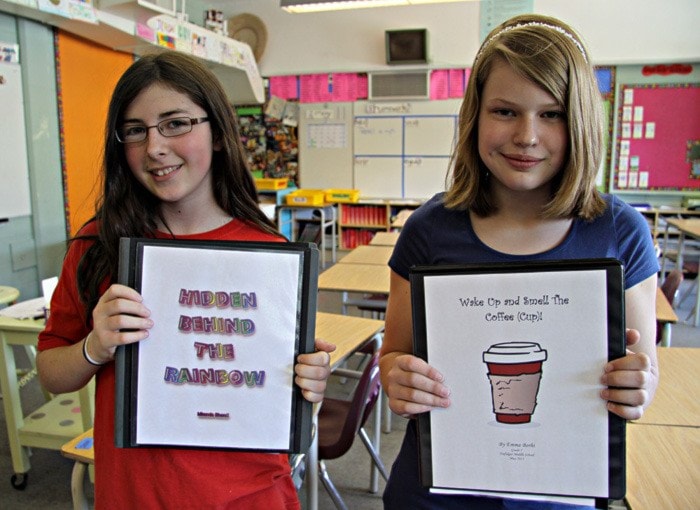Two Grade 7 students from Trafalgar Middle School head to Toronto tomorrow to share the fruits of their scientific labours at a weeklong Canada-wide fair.
Emma Bohri, 12, and Miranda Sherell, 13, qualified for the event by earning top marks last month at the West Kootenay regional science fair in Nelson.
Sherell’s project is called Hidden Behind the Rainbow: Does Colour Affect Flavour Perception? while Bohri’s is Wake Up and Smell the Coffee (Cup)! How Fast Do Coffee Cups Biodegrade?
Bohri says the idea actually came to her a couple of years ago.
“My dad drinks a lot of coffee out of paper cups. So I went to six different coffee shops in Nelson and Tim Hortons in Castlegar and asked for cups.”
To simulate the effects of a landfill, she buried six cups — three paper, two plastic, and one biodegradable — in her backyard and dug them up one year, nine months, and 13 days later.
“The plastic ones could have been washed and reused,” she says. “There was really no difference. The biodegradable one from the Kootenay Bakery biodegraded. If I had left it there for a couple more months, there would have been nothing left.”
However, the paper cups had a plastic liner which did not break down, and “I think that would be there for a really long time.”
She also buried the cup lids, made of No. 6 plastic, “so they don’t biodegrade and they’re not recyclable. Those are probably a bigger problem than the actual cup.”
At the regional fair she displayed the unearthed cups next to new ones.
Her conclusion? Biodegradable cups are probably best if they’re bound for the trash. Plastic cups have the advantage of being reusable and recyclable. Paper cups, if fully recyclable, are fine, but for now she would avoid them.
For Sherell, meanwhile, inspiration struck while eating a purple Freezie.
“I thought ‘This does not taste like grape at all. I wonder if other people would think this Freezie is grape flavoured just because it’s purple.’”
To test the idea, she enlisted 50 fellow Grade 7 students — 25 boys, 25 girls — to taste yogurt samples. All were vanilla, but she added food colouring to create batches of red, blue and, yellow, and asked participants to name the flavour.
“I found most people, if it was red, thought it was strawberry or raspberry. Yellow they thought was peach, lemon, or banana, and if it was blue, they almost invariably thought it was blueberry. It’s amazing — people are just so affected by the colour.”
Ahead of the national fair, she tried another experiment. This time, all the yogurt samples were white, but flavoured raspberry, blueberry, or pineapple.
“Most people found it much more difficult to identify the flavour if it wasn’t coloured to correspond to that flavour,” Sherell says. “A lot of people said vanilla just because it was white. Maybe five out of 50 actually got the right flavour.”
In a third experiment, she created a raspberry flavoured yellow batch, a blueberry flavoured red batch, and a pineapple flavoured blue batch. The results again showed colour was the dominant factor.
Trafalgar teacher Ann McDonnell, who helped organize the regional fair, says it’s just coincidence the top two students came from the same school. The fair drew 85 participants from public, Catholic, and alternative schools around the West Kootenay Boundary.
Sherell and Bohri received cash and other prizes for impressing the judges, but McDonnell wasn’t sure at first if anyone would attend the nationals, which requires further developing each idea.
“But the judges talked to these girls and they were very willing to extend their projects. They’ve probably done more work in the last month and a half than on the entire projects at the beginning.”
In addition to local fundraising, bursaries from the Science Fair Foundation of B.C. and the Kootenay Association for Science and Technology will help the girls get to Toronto, where they’ll spend three days showing off their projects to judges, other students, and the general public.
“I’m excited to take them,” McDonnell says. “I initially said as a Grade 7 student, you’re winning the experience of going to the Canada Fair. There are 500 projects, so it’s massive. Now I’m excited to see what might happen because they’ve done so much more work.”
The national fair includes $1 million in scholarships, cash, and other prizes.
(CORRECTION: An earlier version of this story stated that Science World provided a bursary to help the students get to Toronto. In fact, this funding was from the Science Fair Foundation of B.C.)
